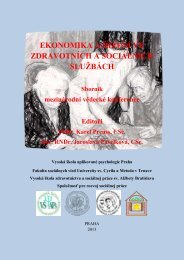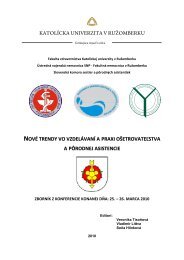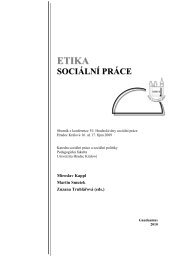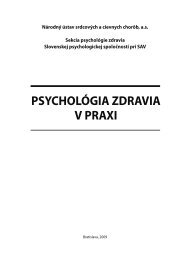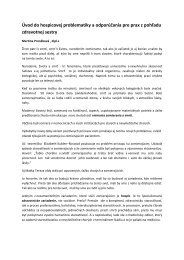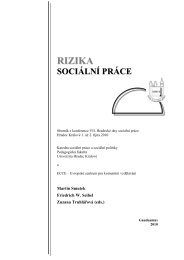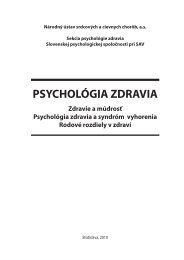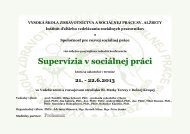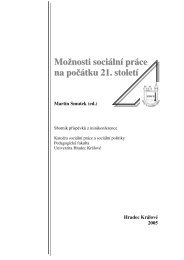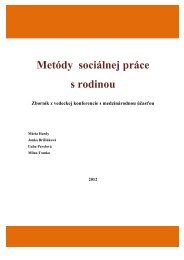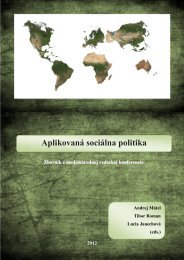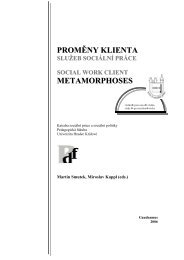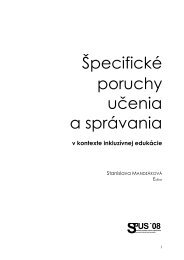Zmena klÃmy â možný dopad (nielen) na obyvateľstvo - Prohuman
Zmena klÃmy â možný dopad (nielen) na obyvateľstvo - Prohuman
Zmena klÃmy â možný dopad (nielen) na obyvateľstvo - Prohuman
You also want an ePaper? Increase the reach of your titles
YUMPU automatically turns print PDFs into web optimized ePapers that Google loves.
Communication on Climate Change, 1995). New series of sce<strong>na</strong>rios have been issued<br />
step by step in 1995–2009 (5th Slovak Natio<strong>na</strong>l Communication on Climate<br />
Change, 2009). Outputs from four GCMs (CGCM3.1, ECHAM5, KNMI and MPI) have<br />
been used in the daily data downscaling as new climate change sce<strong>na</strong>rios for Slovakia<br />
since 2011. These models belong to the newest category of so-called coupled<br />
atmosphere-ocean models with detail network of grid points. Now only selected<br />
results from the newest climate change sce<strong>na</strong>rios are presented in Figs. 5, 8 and 9<br />
(Lapin et al., 2012).<br />
All from these model outputs and downscaling methods e<strong>na</strong>ble to prepare also<br />
combined sce<strong>na</strong>rios based on the GCMs and RCMs modified outputs and regression<br />
or physical relations among climatic variables. Potential evapotranspiration<br />
(Eo) monthly sum series can be considered as one of possible combined sce<strong>na</strong>rios.<br />
Importance of Eo sums change can be seen in Table 1, where monthly and annual<br />
30-year average Eo sums for Hurbanovo are shown. More about measured Eo is<br />
published in Hrvoľ et al. (2012). Using simple Zubenok (1976) method the future<br />
Eo sce<strong>na</strong>rios can be calculated just from the saturation deficit monthly averages.<br />
Another combined sce<strong>na</strong>rios are (monthly values): snow cover depth, number<br />
of snow cover days, runoff, soil moisture, occurrence of heat waves, occurrence<br />
of thunderstorms and flash floods etc. (Lapin and Melo, 2004, Lapin et al., 2009).<br />
Table 1. Sce<strong>na</strong>rios of monthly and annual sums of the potential evapotranspiration<br />
Eo (in mm) in 2011–2040 (2025 time frame) and in 2071–2100 (2085 time frame)<br />
by 4 different RCMs and GCMs models for Hurbanovo, HURB 1961–1990 – calculated<br />
according to the measured values, all by the Zubenok method.<br />
I II III IV V VI VII VIII IX X XI XII Year<br />
HURB 1961–1990 11.7 19.1 47.1 84.3 111.7 130.1 133.7 112.4 77.1 46.8 22.8 12.1 808.9<br />
KNMI A1B 2025 12.5 20.6 52.1 92.2 118.3 135.2 141.0 118.1 82.6 49.6 24.4 12.7 859.4<br />
KNMI A1B 2085 14.7 22.3 54.8 93.7 126.5 148.4 156.6 130.6 86.8 52.7 25.9 13.7 926.7<br />
MPI A1B 2025 14.3 20.7 52.2 91.4 111.2 133.4 136.7 122.4 84.4 52.6 25.9 13.9 859.0<br />
MPI A1B 2085 19.1 25.5 54.6 90.3 116.3 141.7 148.0 135.9 95.3 56.2 29.6 17.0 929.6<br />
CGCM3.1 A2 2025 12.7 21.2 48.2 91.4 116.8 137.7 136.0 120.4 85.1 52.6 23.2 12.2 857.5<br />
CGCM3.1 A2 2085 12.4 21.2 49.3 103.7 123.6 141.5 143.0 135.5 96.7 57.8 27.8 14.1 926.6<br />
CGCM3.1 B1 2025 12.3 22.4 48.0 90.0 117.9 135.3 135.5 116.5 80.2 50.4 24.2 12.7 845.3<br />
CGCM3.1 B1 2085 11.8 20.4 45.8 95.9 117.6 138.7 136.7 122.5 84.3 53.3 24.5 13.6 865.1<br />
97




